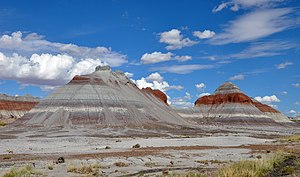Petrified Forest National Park
| Petrified Forest National Park | |
| U.S. National Park | |
|
The Tepees
|
|
| Named for: Petrified wood found in the park | |
| Country | United States |
|---|---|
| State | Arizona |
| Counties | Apache, Navajo |
| Location | Near Holbrook |
| - elevation | 5,436 ft (1,657 m) |
| - coordinates | 35°05′17″N 109°48′23″W / 35.08806°N 109.80639°WCoordinates: 35°05′17″N 109°48′23″W / 35.08806°N 109.80639°W |
| Highest point | |
| - elevation | 6,235 ft (1,900 m) |
| Lowest point | |
| - elevation | 5,300 ft (1,615 m) |
| NPS fee area | 146,930 acres (59,460 ha) |
| - Designated wilderness | 50,260 acres (20,340 ha) |
| National Park | 1962 |
| - National Monument | 1906 |
| Management | National Park Service |
| Visitation | 793,225 (2015) |
| IUCN category | II - National Park |
| Website: Petrified Forest National Park | |
Petrified Forest National Park is a United States national park in Navajo and Apache counties in northeastern Arizona. Named for its large deposits of petrified wood, the fee area of the park covers about 230 square miles (600 square kilometers), encompassing semi-desert shrub steppe as well as highly eroded and colorful badlands. The park's headquarters is about 26 miles (42 km) east of Holbrook along Interstate 40 (I-40), which parallels the BNSF Railway's Southern Transcon, the Puerco River, and historic U.S. Route 66, all crossing the park roughly east–west. The site, the northern part of which extends into the Painted Desert, was declared a national monument in 1906 and a national park in 1962. About 800,000 people visit the park each year and take part in activities including sightseeing, photography, hiking, and backpacking.
Averaging about 5,400 feet (1,600 m) in elevation, the park has a dry windy climate with temperatures that vary from summer highs of about 100 °F (38 °C) to winter lows well below freezing. More than 400 species of plants, dominated by grasses such as bunchgrass, blue grama, and sacaton, are found in the park. Fauna include larger animals such as pronghorns, coyotes, and bobcats, many smaller animals, such as deer mice, snakes, lizards, seven kinds of amphibians, and more than 200 species of birds, some of which are permanent residents and many of which are migratory. About half of the park is designated wilderness.
...
Wikipedia


